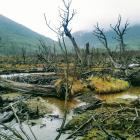In 1946, Argentina introduced twenty beavers (Castor canadensis) to Tierra del Fuego (TdF) to promote the fur industry in a land deemed empty and sterile. Beavers were brought from Canada by Tom Lamb, a settler known as Mr. North for having expanded the national frontier and having restocked the beaver population that had almost gone extinct after savage fur trading.
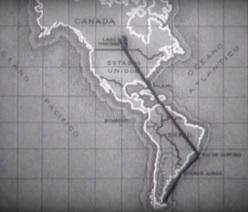
Map of the trip taken by the original beavers from Canada to Argentina in 1946.
Map of the trip taken by the original beavers from Canada to Argentina in 1946.
Illustration by Antonio A. Díaz, 1946.
From “Viaje al Sur.” Noticiero cinematográfico Sucesos Argentinos, Video File.
Courtesy of the General Archive of the Nation (Argentina).
Used by permission.
The copyright holder reserves, or holds for their own use, all the rights provided by copyright law, such as distribution, performance, and creation of derivative works.
In the 1980s, local scientists began to assess the epoch I call the “Beavercene”: they found that beavers were the main disturbers of sub-Antarctic forests. The fur industry had never been implemented in TdF and, without predators, beavers had expanded, crossed to Chile, and occupied most of the river streams. The Beavercene resulted in apocalyptic landscapes without industrial surplus: dams, organically modified rivers, flooded lands, and dead native trees that, unlike the Canadian ones, are not resilient to flooding. In the 1980s, regional institutions started to control the beavers’ populations by promoting hunting, a fur trade, and beaver meat diets.
In 2008, new transnational environmental actors entered the region and substituted the population control paradigm for one of invasive species eradication, a framing that qualified for significant international funding. However, today that funding is near its end, and my informants do not believe that eradication is possible, especially given the harsh conditions of the region and the lack of institutional continuity. My archival-ethnographic research shows that the Beavercene materializes not only beavers’ engineering capacities but also a history of colonial interventions that ignore local environments.
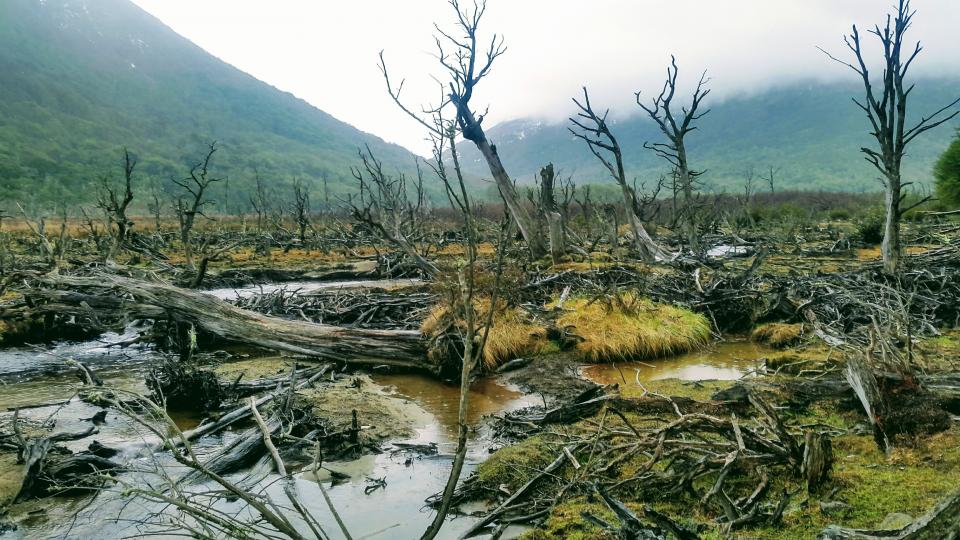
Ruinated landscapes of imperial failed adaptations.
Ruinated landscapes of imperial failed adaptations.
© 2018 Mara Dicenta
Used by permission.
 This work is licensed under a Creative Commons Attribution 4.0 International License.
This work is licensed under a Creative Commons Attribution 4.0 International License.
Unlike other regions of Argentina, TdF was not colonized by European explorers (who had visited the region without staying) but rather by the national state. At the end of the nineteenth century the state donated lands to Europeans who, in building their farms, also displaced and assassinated the indigenous inhabitants of TdF. With the settlers, livestock and plants also invaded the region, an “ecological imperialism” that displaced native populations. In doing this, eugenic and racializing knowledges mediated the human and nonhuman population politics of TdF.
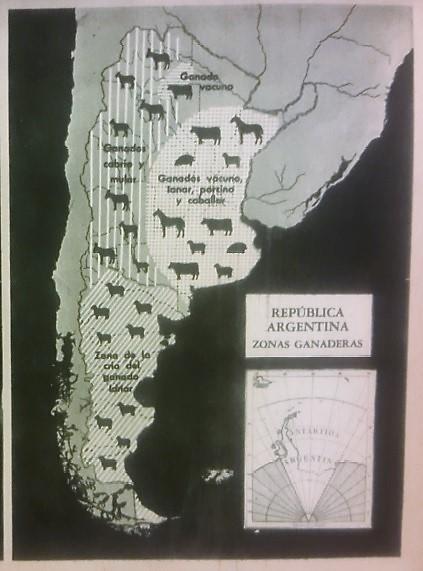
Nationalization of Argentina with more-than-human settlers. Note that here, TdF is still represented as an empty land to occupy.
Nationalization of Argentina with more-than-human settlers. Note that here, TdF is still represented as an empty land to occupy.
Map by J. C. Astolfi, B. Aizcorbe, and A. E. J. Fesquet, 1950. El Trabajo en la zona Agropecuaria, Kapelusz.
Courtesy of the Peronist Archives at the Argentinian Congress Library.
 This work is licensed under a Creative Commons Public Domain Mark 1.0 License.
This work is licensed under a Creative Commons Public Domain Mark 1.0 License.
In the 1940s, the Argentinian State nationalized these settlers’ capitals by redistributing their lands. In turn, the settlers defended their ownership. In 1946, the president of the rural association in TdF opened the yearly livestock conquest:
We, settlers and farmers of TdF have lived the evolution of this territory from the times of an absent State.
The settlers are today considered Fuegians in opposition to newcomers, but in the 1940s, they used to reserve this category for the indigenous inhabitants. To become Fuegians, they allied with their introduced animals, like the Patagonian sheep or the Fuegian beaver. At a time when, after the two world wars, the category of race had become scientifically delegitimized, the enhancement and industrialization of animals enabled the continuation of racializing politics. In 1946, during the same livestock ceremony in TdF, the military government claimed:
This ceremony represents the patria; it spreads the purification of our races … It is our desire to produce an even more purified and refined race to, directly, achieve the aggrandizement of Argentina.
The increasing entanglement between animal breeding and the nation helped to continue the underlying Darwinist logic embedded in population politics. Previous explicit desires to whiten the Argentinian race started to be actualized in other terms. In a recent interview, when complaining about the beavers’ eradication, a Chilean truck driver framed them in xenophobic logic:
Why bother killing the beavers if we have bigger problems with immigrants from neighboring populations?
Owning nature, settlers and their cattle defined themselves as the native population that pre-existed the state. With that, they installed a foundational myth that, as shown in the official accounts of Arnoldo Canclini or Lucas Bridges, leaves the indigenous people outside historical time. During my interviews, a local councilor and settler-descendent, defined herself as Fuegian in opposition to the indigenous and newcomers:
The problem are the newcomers who cut down the forest to settle. Before it was different, yes, the others were Indians.

A tourist shop in Ushuaia, showing the commodified mannequins of Selk’nam peoples next to a beaver.
A tourist shop in Ushuaia, showing the commodified mannequins of Selk’nam peoples next to a beaver.
© 2019 Mara Dicenta
Used by permission.
The copyright holder reserves, or holds for their own use, all the rights provided by copyright law, such as distribution, performance, and creation of derivative works.
Settlers had not only legitimated their belonging to TdF by othering the indigenous, as the quote above claims, but also through the idea that indigenous communities had gone extinct after genocide and disease. At that time, the “myth of extinction” helped in the construction of a uniform nation based on erasing difference, as a geography textbook for school students, Historia y Geografía Argentinas, explained in 1952:
If in 1852 there were 900,000 inhabitants divided in 90,000 whites, 585,000 mestizos, 90,000 Indians and 135.000 Mulatos and Black, a century later there was a 90% of white population out of 18,000,000 inhabitants. (357)
As shown in this 1950s textbook, state statistics contributed to the erasure of non-white peoples through the magic of numbers: it is not that they had disappeared, but that they had been statistically exceeded (using those numbers differently shows 1,800,000 non-white people in 1952, 222% more). However, repressed communities never fully disappear. In my research, I found that through the environment, these repressed histories make appear through the mobilization of scientized and depoliticized natures. As an indigenous activist harshly told me when discussing the beavers’ conflict:
We must kill them all. We cannot kill humans today; it is neither legal nor ethical. But we have to kill the animals, they are not from here.
If once scientific natures legitimated settlers belonging, those same knowledges are today used for disrupting settler-colonial politics. In TdF, science not only serves domination, but it also enables decolonial claims.
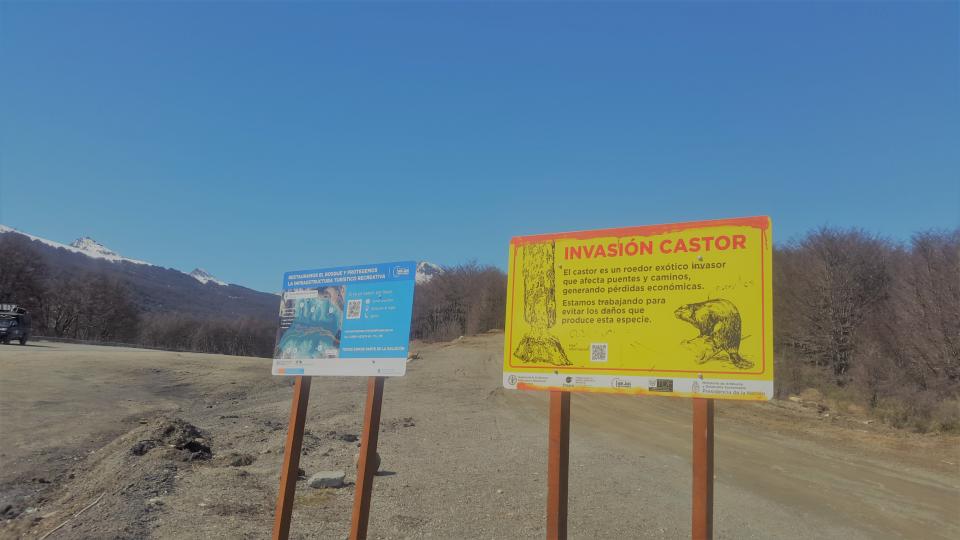
The Beavercene: Warning Signs calling for citizens´ participation in registering beavers’ presence.
The Beavercene: Warning Signs calling for citizens´ participation in registering beavers’ presence.
© 2018 Mara Dicenta
Used by permission.
The copyright holder reserves, or holds for their own use, all the rights provided by copyright law, such as distribution, performance, and creation of derivative works.
How to cite
Dicenta, Mara. “The Beavercene: Eradication and Settler-Colonialism in Tierra del Fuego.” Environment & Society Portal, Arcadia (Spring 2020), no. 1. Rachel Carson Center for Environment and Society. doi.org/10.5282/rcc/8973.
ISSN 2199-3408
Environment & Society Portal, Arcadia
 This work is licensed under a Creative Commons Attribution 4.0 International License.
This work is licensed under a Creative Commons Attribution 4.0 International License.
2020 Mara Dicenta
This refers only to the text and does not include any image rights.
Please click on the images to view their individual rights status.
- Anderson, Christopher B., Guillermo Martínez Pastur, María Vanessa Lencinas, Petra K. Wallem, Michelle C. Moorman, and Amy D. Rosemond. “Do Introduced North American Beavers Castor canadensis Engineer Differently in Southern South America? An Overview with Implications for Restoration.” Mammal Review 39, no. 1 (2009): 33–52.
- Blair, James J. A. “Settler Indigeneity and the Eradication of the Non-Native: Self-Determination and Biosecurity in the Falkland Islands (Malvinas).” Journal of the Royal Anthropological Institute 23, no. 3 (2017): 580–602.
- Crosby, Alfred W. “Ecological Imperialism: The Overseas Migration of Western Europeans as a Biological Phenomenon.” In The Ends of the Earth: Perspectives on Modern Environmental History, edited by Donald Worster and Alfred W. Crosby, 103–17. Cambridge: Cambridge University Press, 1988.
- Muñiz, Juan. “Las Exposiciones de 1946.” Argentina Austral 17, no. 178 (1946): 19–22.
- Novick, Susana. Política y Población: De Los Conservadores Al Peronismo. Buenos Aires: Instituto de Investigaciones Gino Germani, Facultad de Ciencias Sociales, UBA, 2018.
- Sabsay, Fernando Leonidas, and Mario Manuel Vazquez. Historia y Geografía Argentinas. La Facultad, 1952.
- Wolfe, Patrick. “Settler Colonialism and the Elimination of the Native.” Journal of Genocide Research 8, no. 4 (2006): 387–409.



